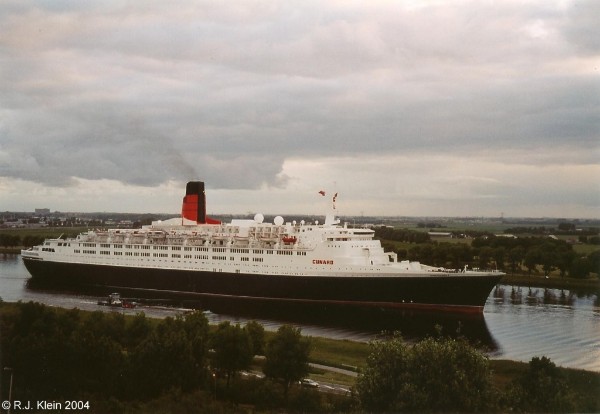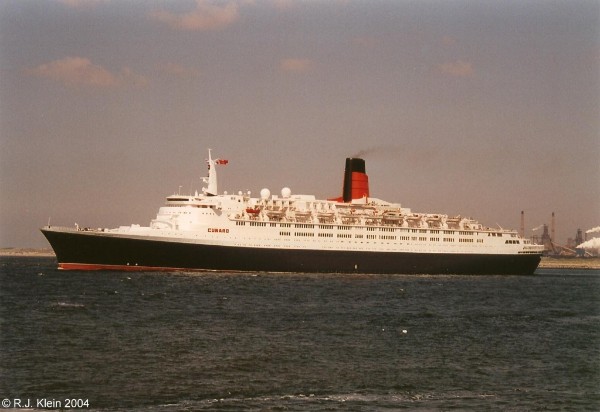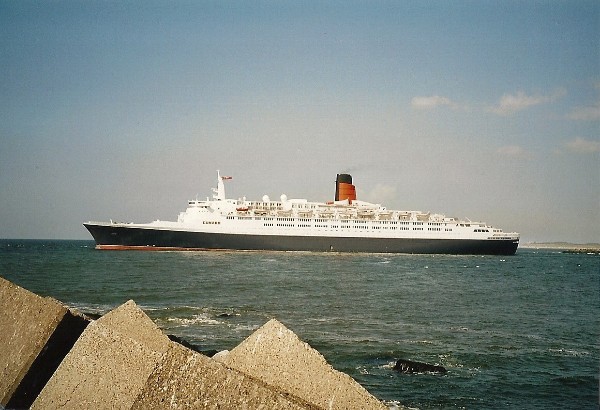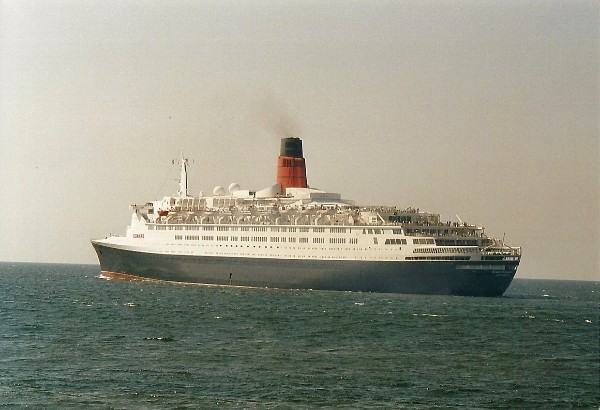Queen Elizabeth 2
Cunard Line was placed in a difficult situation in the late 1950's. They still owned a large fleet of oceanliners, mostly sailing their important routes between Europe and New York and Europe and Canada. This fleet was headed by the biggest ships in the world, the Queen Elizabeth and Queen Mary. Although the ships were still within their economical life, Queen Mary started sailing in 1936 and Queen Elizabeth started commercial sailings in 1946, there were problems on the horizon. Because of the technological growth and knowledge according to airtravel during the second worldwar, it became possible to built longrange passenger-aircraft and these started to become popular around 1960. Now, it was possible to fly across the Atlantic in a few hours instead of sailing in a few days. Because of that, the ships of Cunard Line were losing passengers although people still admired their heroic warduties and they were loved by many. But technology is more important then sentiments, and especially the big Queens were losing not only passengers, but loads of money too. There were times that only a few hundred people were on board and the passengers were outnumbered by the crew. Cunard Line started thinking about replacement and at first they thought about building a similar-sized three-class ship codenamed Q3, the thirth queen. But it soon became clear that ships in the future had to be smaller and easily adaptable for cruising. So this plan was shelved. The profile of Q3 had already been drawn and she really looked like a larger version of the eventual Queen Elizabeth 2.
In 1962, another blow came when the Compagnie Generale Transatlantique, the French Line, introduced a modern ocean giant named France. On the already declining North Atlantic, her introduction was a deadly blow to the older classic megaships. Even this new liner never made money and Cunard had to act to not go bankrupt in the end. So a new plan was drawn for a replacement of both Queens, the Q4 project. This was going to be a dual-purpose ship, for cruising and transatlantic voyaging, because no one at Cunard's was thinking that transatlantic ships were going to be replaced by aircraft in total. The ship was to be smaller in size and able to transit the Suez and Panama canals. In 1964 tenders were recieved from John Brown at Clydebank, Swan Hunter and Wigham Richardson on the Tyne, Vickers Armstrongs at Barrow and Harland & Wolff in Belfast. All tenders were way too expensive so modifications were made to the design, but even with them, still all tenders seemed to be too expensive. Finally, a contract was signed with John Brown, the company that had also built the two earlier Queens.

The keel was to be laid at the 4th of july 1965, because this was a tradition Cunard keel-laying day. In fact the keel moved some inches that day, but because of the celebration around the anniversary of the sailing of the first Cunard ship Britannia the real keel-laying was postponed a few days. The new Cunard ship was now known as Hull 736. There was huge speculation about what name she would eventually get, names like Queen Victoria, Mauretania, Great Britain and Winston Churchill were all heared. But Cunard Line finally decided that the name of the new liner should be Queen Elizabeth. When the Queen performed the launching ceremony on the 20th of september 1967 all was changed drasticly. When she named the ship, she ignored the name on the card that was presented to her in case she forgot the name. It was saying 'I name this ship Queen Elizabeth..', but the Queen added 'the second' to the name so thats why the ship was eventually called Queen Elizabeth 2. Also, Cunard Line officials were not able to ignore the Queen of course. But the people in Scotland (who built the ship) were very displeased and called the name unimaginative, thoughtless and pretentious. They were very displeased by the name because Scotland only had one Queen Elizabeth! Cunard Line in reaction defended in saying that the ship was to be named not after the reigning Queen but after the former ship. That is why the name was styled Queen Elizabeth 2 instead of Queen Elizabeth II.

The new ship was still a three class ship, although this was really only to be noticed in the restaurants used for dining. Furthermore, every passenger was able to use all of the ship, with some exceptions. Her tonnage was around 70.000, so although smaller then the former Queens, now both out of service, still quite a big liner. She was 293,53 meters long, 32,09 meters wide and her draft was 9,87 meters. The most distinctive and surprising change from the former liners was the funnel. It was very thin and the actual stack was instead of black and red, the traditional colouring, all black. It was surrounded by a white shield for wind deflection. Also, the name of the company, Cunard, was painted on the side of the ship with big, red letters. Inside, the changes with the former, very conservative Cunard style, were also huge. The ship was very modern, and inside felt more like being in a modern day shore hotel then a ship. Also, there was shipwide airconditioning and inside and outside pools. Another new for the company, every cabin was to have private shower and toilet facilities that were, on the former ships, shared by more people in lower classes.
There were to be four maiden voyages, the first one starting on the 10th of january 1969, just four days of cruising to wherever the captain wanted to go, then the second one was to be a 13 day trip to New York starting january 17 followed by a return transatlatic from New York starting march 11. The last maiden was to be a Mediterranean cruise from Southampton starting april 3 in Southampton. A serious plan was to sail a weekly transatlantic service together with the France. This made perfectly sense, because both companies could continue their transatlantic services without interferring too much because competition was no good to both of them. This sceme never happened. The seatrials were planned starting the 4th of december 1968, but because of oil leakage this had to be postponed untill the 23rd of december. But on this voyage the engines broke down and the ship had to limp back into Southampton. Very bad publicity of course and all voyages were cancelled. Cunard Line refused delivery and a few months were needed to fix the problems.
Finally, at the 22nd of april 1969, the ship undertook her first cruise to the Canaries after being delivered to the company on the 18th of that month. Her first Southampton to New York transatlantic crossing started at the 2nd of may. Her first years were very evenfull. In 1971, Cunard Line was sold to Travalgar House Investments and stopped being an independend company. Also in 1971, at the 9th of january, the QE2, how she was gently nicknamed, was involved in a rescue-mission to safe the passengers and crew of the French Line ship Antilles, that burned out at the North Atlantic. Luckily, everyone was saved. One year later, on the 17th of may 1972, a serious bombwarning was made. The ship would be blown up when no ransom was to be paid. Normally, you would think of a hoax and it seemed that it also was. Bomb disposal personnel was parachuted onto the ship and bombs were not found. But the ransom had been paid and delivered to the place it was to be delivered, but no one came to claim it so the money was returned to Cunard. An arrest was made. In 1974, the film 'Juggernaut' starring Omar Sharif, Anthony Hopkins and Maxim Gorkiy, was loosely based on the bombtreat aboard QE2. In the between year 1973, another problem arose when the ship was chartered to commemorate the 25th anniversary of Israel. It was a big thank you to president Anwar Sadat of Egypt who prevented an attempt by the Lybian president Ghadaffi to torpedo the ship while sailing on this charter. In the beginning of april 1974, the ship again made headlines when the machinery broke down during a cruise near Barbados and all 1600 passengers had to be taken onboard Sea Venture of Flagship Cruises.

In 1978, more luxury cabins were added to the top decks behind the bridge and although they slightly ruined her original profile, these cabins were to earn a lot of extra money for the company. These later years in the 1970's and early 1980's the ship was in calmer waters then before. This peace lasted untill 1982, when she was requisitioned as a troopcarrier for the Falklands War. She sailed from Southampton to South Georgia filled with troops at the 12th of may of that year, transferring her troops onboard P&O's Canberra for the rest of the trip to the Falklands. The British government wouldn't dare to risk a ship named after an English queen to be too much in harms way and Canberra...well...thats just the capital of Australia, right? QE2 arrived back at Southampton on the 11th of june 1982 and recieved a heroes welcome. The popularity of the ship, together with Canberra of course, was at an enormous peak in those years. With her return, Cunard had to rebuilt her again as a passengerliner and some other alterations were also made. She recieved a grey bow instead of the normal darkblue. But the new paintwork was disastrous for her looks because it was not able to withstand all wear and tear at sea, so this was quickly reversed to darkblue on year later. On the 28th of november 1983, the ship headed to the Lloyd Werft in Bremerhaven to be refitted and repainted, and this caused a stirr of negative reactions in Britain. Why Germany, and why was there no British wharf good enough to do the job? When the ship was sent to Lloyd Werft again in 1986, to have her steamplant replaced by a more economical diesel-electric one, there was displeasement again in Britain over the same fact and this even lead to question being asked in the British Parliament about why a German yard had to do this. During this rebuilding in 1986, also the funnel was changed. A chunkier one, painted in traditional Cunard red and black, was replacing the skinny black and white one and this improved her looks in a huge way. The interiours, especially the restaurants, got a big makeover and also eight new penthouse suites were added. Also, a computer learning center was added, a new item at sea.It was estimated that her lifespan was lenghtened by some 25 years because of this refit and the ship would be sailing Cunard into the next millennium. A very few incidents happened to the ship within the late 1980's and the beginning of the 1990's, apart from a freakwave in 1995, measuring some 90 feet in height, the same level as the bridge. The ship nearly capsized, but in her own style she righted herself up and survived.

During 1996, Travalgar House sold Cunard Line to a consortium headed by the Norwegian constructionfirm Kvearner. For the first time, Cunard Line was no longer a British company. This was only possible because it was officially Trafalgar House that was sold, Cunard Line alone was too important for the British government because of the incidential need for large troopships in periods of war. This is one of the reasons why the Queen Elizabeth 2 kept her British registration after the sale. The only thing Kvearner did to the Cunard Line was reducing the fleet. Several ships were sold, Cunard Princess to MSC, Cunard Countess to Awani and Sagafjord to Transocean Cruises, later Saga Cruises. Carnival Cruise Lines became interested when Kvearner hinted that it would sell Cunard on short term and in may 1998, Cunard was sold to Carnival. After the sale, the fleet was reduced once more to bring the company back to its traditional roots. Royal Viking Sun, Sea Goddess 1 and Sea Goddess 2 were transferred to Seabourn Cruise Line, a company owned by Carnival but placed under the banner of Cunard Line just after the Carnival take-over. So the fleet of the great Cunard Line now was just two ships, Queen Elizabeth 2 and Vistafjord. You can say what you want about Carnival, named Carnivore by some because they 'eat' all cruiselines, but for Cunard it has been a good thing. For the first time since 1971, the company again was owned by a company with shipping as its main field. Furthermore, Carnival stated that Cunard Line would stay an independent part of the company, under its own name and with its own headoffice. The ships also would be registered traditionally in Great Britain. And next to all of this, they immidiately started planning a newbuilt for Cunard that was going to dazzle the world.
The last ships Cunard Line had built were in the mid 1970's the Cunard Princess and Cunard Countess. And these ships were not an order from Cunard Line in the beginning, because this order was taken over from the Hollywood MGM studio. So it was around 25 years ago that the big Cunard Line introduced newbuilt tonnage. For a company with the reputation Cunard has, this is a gap or more a Grand Canyon in its history. Carnival blew new life into the very twisted company, that sailed with so many different namestyles and funnels that it was by no means a firm company anymore. Cunard really lost their own identity during their years under Trafelgar House and Kvaerner and Carnival had to straighten it up again. And they did. While Queen Elizabeth 2 and the renamed Caronia (the former Vistafjord) sailed on and tried to regain some of their strong historic legacy, the 'Project Queen Mary' was introduced as the new Cunard-ship. It was to be the biggest, most expensive and longest ship ever to be built and it was also to be a true transatlantic liner built not only for cruising but for traditional voyages also. Under great media attention and a string of books and documentaries this ship was introduced in 2003 as Queen Mary 2. Although nobody spoke about the fact she was to be a replacement for the QE2, everybody knew that this would soon be the case. One year after the introduction of the biggest ship in the world, finally one thats also longer then the Norway, the former France, Cunard Line withdrew the QE2 from her transatlantic service and this was taken over entirely by the Queen Mary 2. The QE2 was to be a fulltime cruiseship now and she was seen in a lot more countries then she was before. She sailed worldwide, sometimes meeting her new fleetmate. These occations were always very exciting and attracted huge crowds, nicknamed 'Royal Rendezvous'. The QE2 was still an icon. But she was old and aging in the years after the new millennium started. Her glorydays were behind her and she was outdated by every new cruiseship added to the worlds fleet. In september 2008, to the sadness of many, Cunard Line waved goodbye to one of the last great transatlantic ships ever. She was the longest serving ship in Cunards history, better still, the longest serving transatlantic ship sailing for any company in the world. Next to that, she also sailed more miles then any other ship in history. But also ships with this reputation will not go on forever. She was sold to a consortium from the wealthy Dubai to be turned into an tourist center, hotel and icon for the Middle Eastern country.

In 2013, still nothing happened. The economic downturn of recent years was also felt hard in the wealthiest place on earth. The ship lies idle in the port of Dubai and no major work has been done so far. Also, there really are several plans for her use in the future but nothing seems to be concrete anymore. A queen of the oceans is in mothballs and we can just hope she will have some future use. But all in all, she will be remembered as the greatest ship of the last years of transatlantic travelling.
All pictures above were taken in 2004, picture 1 and 3 at the North Sea channel passage in The Netherlands near Spaarnwoude, all other pictures were shot near IJmuiden on the mouth of this channel at the North Sea coast.

